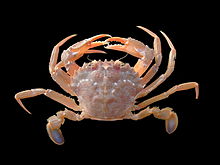| Portunidae | |
|---|---|
 | |
| Liocarcinus depurator | |
| Scientific classification | |
| Domain: | Eukaryota |
| Kingdom: | Animalia |
| Phylum: | Arthropoda |
| Class: | Malacostraca |
| Order: | Decapoda |
| Suborder: | Pleocyemata |
| Infraorder: | Brachyura |
| Superfamily: | Portunoidea |
| Family: | Portunidae Rafinesque, 1815 |
| Subfamilies | |
| |
Portunidae is a family of crabs which contains the swimming crabs. Its members include well-known shoreline crabs such as the blue crab ( Callinectes sapidus ) and velvet crab ( Necora puber ).